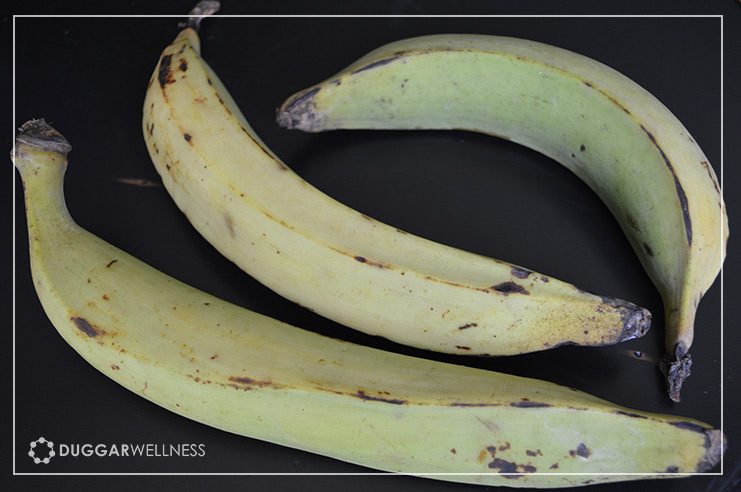What is a Plantain?
That is exactly the question I got asked at the grocery store this week.
Plantains are a member of the banana family. They are starchy, lower in sugar and must be cooked before serving as they are unsuitable raw. Plantains are used in many savory dishes somewhat like a potato would be used and are usually fried or baked.
Where do they come from?
Plantains are indigenous to the tropical regions of Southeast Asia. They made their way along trade routes to Africa and then were brought to the Caribbean by the Spanish and African slave traders. The plantain eventually became a staple ingredient in the Caribbean and are sometimes called the pasta and potatoes of the Caribbean.
Where can I find them?
Plantains are sold in the fresh produce section of the grocery store, and can generally be found year-round. They usually resemble large green bananas, with some black spots and tough skin. They can variety in color based on their ripeness from bright green, yellow and black.
What are the health benefits?
Great Source of Potassium: Potassium plays a major role in regulating blood pressure because it combats the effects of sodium. Potassium levels help regulate heart rhythm, and studies show that people who consume diets with high potassium levels tend to be at a lower risk of high blood pressure, cardiovascular disease, osteoporosis and kidney stones.
Help Regulate the Digestive System: Potassium levels also affect smooth muscle contraction, which allows for regular digestive function. Fiber has a profound effect on the digestive system and plays a significant role in keeping it regular. Plantains are rich in prebiotic fiber essential in maintaining a healthy gut microbiome.
Reduce the Number of Harmful Free Radicals: A serving of plantains can provide over 35 percent of the vitamin C needed per day, making it one of the best vitamin C foods around. Vitamin C boosts the immune system and is a powerful antioxidant that combats free radical damage that increases the aging process, can cause disease and cancer. Vitamin C also helps the body grow and repair tissue in skin, tendons, ligaments and blood vessels, as well as maintaining cartilage, bones and teeth.
Promote Healthy Brain Function: A serving of plantains contains up to 24% of needed vitamin B6. Vitamin B6, also called pyridoxine, generates neurotransmitters that carry information from one cell to another. Vitamin B6 also helps make hormones like serotonin and norepinephrine, which keep moods stable, and melatonin, which regulates the body’s clock.
Great Source of Magnesium: Plantains are an excellent source of needed magnesium. Magnesium is which is important for many important body functions. Magnesium has also long been used to help with migraine headaches, blood sugar control, insomnia and depression.
How do I know they are ripe?
Plantains can be eaten and tastes different at every stage of ripeness. The interior color of the fruit will remain creamy, yellowish or slightly pink.
Green plantains: When plantains are green, the pulp is fairly hard and the peel must be removed with a knife. At this stage, they are very starchy and not very sweet, similar to a potato. This is the best time to make plantain chips.
Yellow plantains: Slightly sweeter and a little less starchy than green plantains. This is the best time to make, “Tostones” (twice fried plantains) and are also good added to stews and savory stir-fry dishes.
Black plantains: Despite their color, black plantains are fully ripe and still good to eat. They are the sweetest and softest at this point and are typically baked and eaten as a dessert. Minimalist Baker has the best recipe for caramelized plantains.
How do I prepare them?
These are two of my favorite recipes for preparing plantains, along with the recipe from Minimalist Baker that I referenced above.
Plantain Chips
Tostones– Twice Fried Plantains

 160 N Main, Bountiful, UT 84010
160 N Main, Bountiful, UT 84010  801-677-7878
801-677-7878


